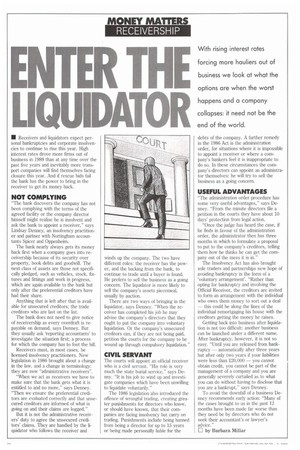EN TER THE
Page 52

If you've noticed an error in this article please click here to report it so we can fix it.
LIQUIDATOR
With rising interest rates forcing more hauliers out of business we look at what the options are when the worst happens and a company collapses: it need not be the end of the world.
• Receivers and liquidators expect personal bankruptcies and corporate insolvencies to continue to rise this year. High interest rates drove more firms out of business in 1989 than at any time over the past five years and inevitably more transport companies will find themselves facing closure this year. And if rescue bids fail the bank has the power to bring in the receiver to get its money back.
NOT COMPLYING
"The bank discovers the company has not been complying with the terms of the agreed facility or the company director himself might realise he is insolvent and ask the bank to appoint a receiver," says Lindsay Denney, an insolvency practitioner and partner with Nottingham accountants Spicer and Oppenheim.
The bank nearly always gets its money back first when a company goes into receivership because of its security over property, book debts and goodwill. The next class of assets are those not specifically pledged, such as vehicles, stock, fixtures and fittings and work in progress, which are again available to the bank but only after the preferential creditors have had their share.
Anything that is left after that is available for unsecured creditors; the trade creditors who are last on the list.
The bank does not need to give notice of receivership as every overdraft is repayable on demand, says Denney. But they usually ask 'reporting accountants' to investigate the situation first; a process for which the company has to foot the bill.
Receivers must, in most cases, be licensed insolvency practitioners. New legislation in 1986 brought about a change in the law, and a change in terminology: they are now "administrative receivers".
"When we act as receivers we have to make sure that the bank gets what it is entitled to and no more," says Denney. "Then we ensure the preferential creditors are evaluated correctly and that unsecured creditors are informed of what is going on and their claims are logged."
But it is not the administrative receivers' duty to agree the unsecured creditors' claims. They are handled by the liquidator who follows the receiver and winds up the company. The two have different roles: the receiver has the power, and the backing from the bank, to continue to trade until a buyer is found. He prefers to sell the business as a going concern. The liquidator is more likely to sell the company's assets piecemeal, usually by auction.
There are two ways of bringing in the liquidator, says Denney. "When the receiver has completed his job he may advise the company's directors that they ought to put the company into voluntary liquidation. Or the company's unsecured creditors can, if they are not being paid, petition the courts for the company to be wound up through compulsory liquidation."
CIVIL SERVANT
The courts will appoint an official receiver who is a civil servant. "His role is very much the state burial service," says Denny. "It is his job to wind up and investigate companies which have been unwilling to liquidate voluntarily."
The 1986 legislation also introduced the offence of wrongful trading, creating greater punishments for directors who know, or should have known, that their companies are facing insolvency but carry on trading. Punishments include being banned from being a director for up to 15 years or being made personally liable for the
debts of the company. A further remedy in the 1986 Act is the administration order, for situations where it is impossible to appoint a receiver or where a company's bankers feel it is inappropriate to do so. In these circumstances the company's directors can appoint an administrator themselves: he will try to sell the business as a going concern.
USEFUL ADVANTAGES
"The administration order procedure has some very useful advantages," says Denney. "From the minute directors file a petition in the courts they have about 10 days' protection from legal action.
"Once the judge has heard the case, if he finds in favour of the administration order, the administrator then has three months in which to formulate a proposal to put to the company's creditors, telling them how he thinks he can get the company out of the mess it is in."
The Insolvency Act has also brought sole traders and partnerships new hope of avoiding bankruptcy in the form of a 'voluntary arrangement'. "Rather than opting for bankruptcy and involving the Official Receiver, the creditors are invited to form an arrangement with the individual who owes them money to sort out a deal — this could be along the lines of the individual remortgaging his house with the creditors getting the money he raises.
Getting back into business after liquidation is not too difficult: another business can be launched under a different name. After bankruptcy, however, it is not so easy. "Until you are released from bankruptcy — automatically after three years but after only two years if your liabilities were less than £20,000 — you cannot obtain credit, you cannot be part of the management of a company and you are generally severely curtailed as to what you can do without having to disclose that you are a bankrupt," says Denney.
To avoid the downfall of a business Denney recommends early action: "Many of the cases brought to us in the past 12 months have been made far worse than they need be by directors who do not seek their accountant's or lawyer's advice."
D by Barbara Millar








































































































